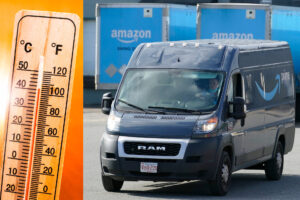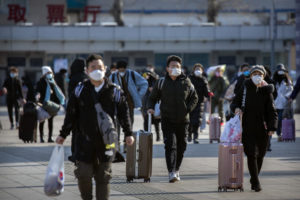China’s Trans-Amazon Railway Would Punch a Path Through a Rainforest
The Asian nation's thirst for minerals and grain and its encroaching development in South America threatens the Amazon's forests, indigenous rights and the atmosphere.By Jan Rocha / Climate News Network
A tight fit at the Panama Canal: The railway will offer cheaper transits—at a cost. (Salvador.C. via Wikimedia Commons)
China’s fast-rising population and its burgeoning economy make steep demands on natural resources, so steep that Beijing is searching constantly for supplies from overseas. And it wants to obtain them, naturally, as cheaply as it can.
Now in prospect is China’s trans-Amazon railway — a 3,300-mile-long (5,000 km) artery to link the soya-growing areas and iron ore mines of Brazil to the southern Peruvian port of Ilo, providing a cheaper, shorter route than the Panama Canal.
Feasibility studies on three different trajectories were carried out by the China Railway Eryuan Engineering Group (CREEC). The route preferred by the Chinese, because it is cheaper and avoids the complex engineering work needed to traverse the Andes, would instead pass through heavily forested areas in the Amazon, home to many indigenous groups in both Brazil and Peru.
Miguel Scarcello, a geographer, from the NGO SOS Amazônia, (Portuguese only) says this route for the railway will also cross the headwaters of many rivers.
Both Brazilian and Peruvian environmental protection agencies have criticised those who chose the route for showing little concern for its impacts. The Peruvian ministries of culture and the environment said that native communities must be consulted.
Responsibility declined
But CREEC representatives told a Brazilian senate subcommittee that the responsibility for conducting studies on the environmental viability of the railway lay with Brazil and Peru.
A study carried out by Brazil’s state-run rail operator, VALEC (Portuguese only), concluded that, besides impacting sensitive ecosystems, the railway would also require the construction of an entire town in the heart of the Amazon to house all the workers it employed. It would also have to cope with tracks of two different widths — the 1.6m gauge used in Brazil, and the standard gauge, 1.4m, in Peru.
China’s trans-Amazon railway was given the go-ahead in May 2015, when Chinese premier Li Keqiang signed a memorandum of understanding with his two South American colleagues — Brazilian president Dilma Rousseff, who has just been impeached, and Peruvian president Ollanta Humala, who is no longer in office — to proceed with feasibility studies.
The 3,300 km Brazilian stretch of the line begins on the Atlantic coast in the newly built port of Açu and runs due west, through the grain heartland of Mato Grosso state, then through the Amazonian states of Rondonia and Acre, to the Peruvian border, and then a further 1,700 km to the Pacific at Puerto Ilo.
In Brazil the line would join other planned railways like the Centre-West Integration Railway, FICO, which will bring grain from neighbouring states. Some of the environmental licences necessary for the building of the railways have yet to be granted, although a bill to speed up the normally lengthy process is now before congress. CREEC wants work on the ambitious US$10bn trans-Amazon railway to begin in 2017, with completion set for 2025.
Saving on shipping
China is keen to build the railway because it would reduce by U$30 a tonne the cost of importing grain and minerals via the Panama Canal. Once operational, the line would be expected to carry a third of Brazil`s soya exports to China, some 35 million tonnes annually.
But for Brazil and Peru, two of the nine countries in which the Amazon rainforest lies, the environmental cost of a railway literally bisecting the Amazon region would be huge. Already about 20% of Brazil`s share of the forest (it is the country with the largest part) has been cleared for roads, cattle or grain.
Between 2000 and 2010 the total Amazon region lost an area the size of the UK, about 240,000 sq. km. In 2005 and 2010 there were serious droughts. The dry season is growing longer, the rainy season shorter.
Scientists believe deforestation is contributing by sending more CO2 into the atmosphere, adding to climate change, which in turn contributes to the droughts. Some even believe that the Amazon rainforest is approaching a tipping point.
Decision appealed
The Chinese onslaught on the Amazon is not confined to the railway. They have signed a deal with Ecuador to explore for oil in its part of Amazonia. And they are part of a consortium seeking to build a giant dam on the Tapajos river in Brazil.
This project was recently suspended by a federal court because it would invade an indigenous area, but it is still on the drawing board. Although it has been suspended it has not been cancelled, and the consortium is appealing against the court’s decision.
Concerns for its devastating social and environmental impacts may not be enough to stop the railway, because both the Brazilian and Peruvian governments seem keener to do business with China than they are to protect their indigenous communities and the so-called lungs of the world, the Amazon rainforest.
What could however prevent the line from becoming a reality is the possibility of an alternative, faster route, which is now taking shape. The BR163 highway, not yet fully paved, runs due north from Mato Grosso to connect with the new river port of Mirititiba on the Tapajos river, near the town of Itaituba.
From there barges will take grain and minerals downriver to the terminal port at Santarem, located at the junction of the Tapajos with the Amazon, and then downstream to the Atlantic.
Using the river system would cause much less environmental damage than a railway, although the BR163, which will feed the ports, has already caused considerable deforestation.
Jan Rocha is a freelance journalist living in Brazil and is a former correspondent there for the BBC World Service and The Guardian.
Your support matters…Independent journalism is under threat and overshadowed by heavily funded mainstream media.
You can help level the playing field. Become a member.
Your tax-deductible contribution keeps us digging beneath the headlines to give you thought-provoking, investigative reporting and analysis that unearths what's really happening- without compromise.
Give today to support our courageous, independent journalists.









You need to be a supporter to comment.
There are currently no responses to this article.
Be the first to respond.